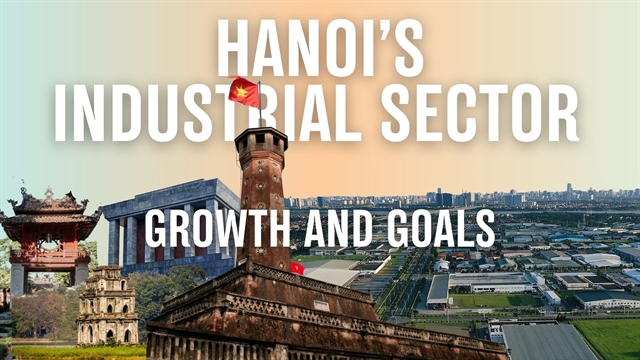 Economy
Economy

Digital banks and neobanks are becoming two familiar terms in Viet Nam’s banking lexicon. In a digitising world, the two will be widely developed around the whole world and in Việt Nam. Việt Nam News’ Thu Ngân speaks to experts about the development of digital banks and neobanks in the country.
Digital banks and neobanks are becoming two familiar terms in Việt Nam’s banking lexicon. The two will be widely developed around the whole world and in Việt Nam. Việt Nam News reporter Thu Ngân speaks to experts about the development of digital banks and neobanks in the country.
Do you think Việt Nam has appropriate infrastructure for neobanks to develop? How do you see their development in this country?

|
| Nguyễn Thiện Tâm, Digital Strategy Director, OCB |
Nguyễn Thiện Tâm, Digital Strategy Director, OCB: We’re currently seeing many successful case studies of neobanks across the world such as Revolut, N26 in Europe, Nubank in Brazil, Kakaobank in Korea with these internet-only banks growing their customer base to millions in matter of 1-2 years. Further, many countries in Asia are granting virtual bank licences to new entrants such as telco companies, insurance giants, leading fintech firms, etc… and soon we will see these neobanks will disrupt the financial industry with very innovative, life-style-driven and high-value products and services.
Việt Nam has many favourable conditions for neobanks to develop and rapidly scale up. One of which is a large population of almost 100 million with very high adoption of smartphones and the internet, tech savviness and openness to try out new digital products as we have seen with the very high growth in e-wallets, e-commerce, ride sharing, and online food ordering in the last few years. In fact, a few such as Timo, Yolo by Vpbank, Livebank by TPBank, and OMNI by OCB have attempted to capture this opportunity early. More and more traditional banks are starting to invest more in digital services on mobile, web and partner platforms. A legal framework for neobanks to operate is not yet in place in Việt Nam, but the recent positive developments such as approval to pilot Mobile Money, serious discussions or proposals to allow Ekyc for onboarding new customers and P2P lending lead us to believe that neobank licensing is not too far in the future. Riddhi Dutta, Regional Head for ASEAN & India, Backbase: The outlook for fintech and digital banking growth is promising in Việt Nam, which is known as a mobile-first market with nearly all internet users owning a smartphone and 75 per cent using it as their preferred connection device. Mobile is also the primary digital platform in rural Việt Nam where 70 per cent of the population lives.
Mobile transactions in Việt Nam are expected to increase by 400 per cent by 2025, according to our 2025 Fintech and Digital Banking report. This means that Vietnamese consumers are increasingly turning to the mobile and internet for financial payments and transactions. Further, we found that core banking and payments system modernisation are the top two priorities with a projected 50 per cent growth in new accounts using intelligent automation in account origination by 2025 for the top eight banks in Việt Nam.
On the other hand, neobanks will be competing with traditional banks as the latter make investments in IT, particularly mobile channels, branch digitisation and workflow optimisation, to support an increasingly digital consumer banking segment.
Claude Spiese, senior Adviser, digitech innovation, Grant Thornton Vietnam Ltd: Việt Nam has a very appropriate infrastructure for neobanks – high mobile phone usage, good internet coverage and robust gateways for funds transfer, ATM withdrawal and bill payment. I believe the regulatory environment will allow for the successful development of neobanks that are both reputable and innovative to fulfil an unmet customer needs.
What are the risks developers face when setting up a neobank here? How can they avoid them?
Riddhi Dutta, Regional Head for ASEAN & India, Backbase: New challengers or neobanks may find that incumbent banks and joint stock banks in particular are poised to win a larger market share thanks to enhanced features in their mobile offerings. This includes gamification, improved data security and customer journey designs for integrated omni-channel customer experiences to cater to the psyche of customers.
To be competitive, new entrants need to own the customer experience and offer personalisation at scale. This means that each touchpoint, be it digital or human, should connect all other components seamlessly and eliminate friction.
Claude Spiese, senior Adviser, digitech innovation, Grant Thornton Vietnam Ltd: The main risks developers face while setting up a neobank here are the same as anywhere in the world – they must have a compelling offering and a sustainable business model. There is also some regulatory risk, but that can be mitigated if well managed, and also market and partnership risks if the developer does not understand Việt Nam's business environment.
What is the future of traditional banks amid the rising trend of neobanks globally including Việt Nam?
Nguyễn Thiện Tâm, Digital Strategy Director, OCB: Neobanks are not yet in Việt Nam but some local banks have invested aggressively in digital banking in recent years as one of the defence strategies to protect their existing customer base and to grow it. I think this is very positive for the banking industry as traditional banks have been pressured to change faster, develop or partner with fintech players to develop more and more digital products to meet the growing demands of customers
While more and more customers are doing their banking online, I believe customers still value good customer service offered by bank staff, and so local banks can still leverage their large branch networks and staffs to deepen the relationship with customers by providing a good mix of excellent online experience and warm human interaction. This will continue to be traditional banks’ core advantage over neobanks. Traditional banks will be up to the task of developing high-value and experience-driven products as fast as neobanks to compete for customers.

|
| Riddhi Dutta, Regional Head for ASEAN & India, Backbase |
Riddhi Dutta, Regional Head for ASEAN & India, Backbase: According to our 2025 Fintech and Digital Banking report, the Asia Pacific will see 100 new financial institutions by 2025 ushered in by the liberalisation of several markets in the region and issuance of new banking licences. Increasingly and rapidly, we will see these new challengers shift their focus towards personalisation-at-scale in order to engage with consumers’ financial lives seamlessly through digital-first platforms.
Traditional banks are well aware of the trajectory towards a digital-first reality and we have found that by 2025, a quarter of banks in Việt Nam will actively pursue modern digital core platforms. That said, traditional banks will be faced with an urgency to ramp up efforts to ensure digital delivery of their services. With 38 per cent of traditional banks’ revenues at risk by 2025, incumbents need to take advantage of potential eco-system partners and solutions to power seamless customer experience, unify data and functionality from core banking systems and personalisation-at-scale.
Claude Spiese, senior Adviser, digitech innovation, Grant Thornton Vietnam Ltd: Traditional banks will both compete with full-stack neobanks (who have their own back end) and partner with half-stack neobanks (who do not have their own back end) by acting as a back end through Open APIs. Successful neobanks will operate in niche markets where traditional banks are not strong. The market share of traditional banks will drop somewhat but then level off as traditional banks themselves innovate and go digital.
In terms of digital banking, what are the challenges banks face in the country?
Nguyễn Thiện Tâm, Digital Strategy Director, OCB: The biggest challenge is with regard to infrastructure: most traditional banks are bogged down by their legacy infrastructure, reliance on legacy systems and lack of customer understanding. Old systems require deep knowledge to understand and control while digital product development requires agility, flexibility and speed. Another key challenge is the culture and people inside the organisation where new product ideas that divert away from day to day or norm can be rejected quickly or challenged hard. Lastly, the level of trust in doing banking transactions online is still low among older, affluent customers.
Riddhi Dutta, Regional Head for ASEAN & India, Backbase: The challenges facing incumbent banks include legacy views of the value chain, legacy in-house architecture and being slow to innovate and leverage customer insights due to data silos.
Firstly, traditional incumbent banks tend to hold legacy views where they want to own the entire value chain instead of taking advantage of potential eco-system play. According to our 2025 Fintech and Digital Banking (Asia Pacific), 80 per cent of the top 250 banks still prefer to own the entire value chain of banking, with third party-contributed business being a mere 2 per cent. Having said that, incumbents have not been able to match the speed of implementation of fintechs. Incumbents may increasingly lose ground if they do not move away from legacy views and refocus their resources into innovating and enhancing the overall experience for customers.
Moreover, incumbent banks tend to be held back by traditional products and processes and outdated technology architectures that form the foundation of their back-end environments. Meanwhile, more than 35 neobanks or new digital challengers across APAC are built on agile innovative best practices and are way ahead of incumbents in terms of flexibility, self-service capabilities, customer needs, and personalisation.
Furthermore, incumbent banks tend to be structured in silos. We call these internal silos which exist within the various department in the bank as “channel islands”. These internal silos affect the entire customer life cycle management. For example, new customer onboarding, self-servicing/advisory/support unit is separate from the product development/provision and apart from the digital marketing division. Banks should instead make this customer journey into a horizontal offering by standardising all four operations into a single platform.

|
| Claude Spiese, senior Adviser, digitech innovation, Grant Thornton Vietnam Ltd. |
Claude Spiese, senior Adviser, digitech innovation, Grant Thornton Vietnam Ltd: All the pieces are in place for the continued growth of digital banking. The main hurdle is the mindset and organisational culture of traditional banks.
Since banks are developing digital banking services, how can they ensure security?
Nguyễn Thiện Tâm, Digital Strategy Director, OCB: Security is very important as this is the key element to gain customer trust in using online banking services. This is why all banks have to ensure customers' financial assets, transactions and information are fully secured. At OCB, we have invested heavily in security systems, solutions such as biometrics for customer authentication, multi-layered security, and cert pinning and mobile security shield layer to protect from hackers. Further, we regularly conduct rigorous assessments of internal processes to detect any potential risks and fix them quickly. Online thefts or fraud can happen if customers expose their online banking access information to fraudsters, and so we regularly alert and inform customers about these potential risks.
Riddhi Dutta, Regional Head for ASEAN & India, Backbase: To ensure successful transition to a digital economy, security must be at the centre of all digital transformation efforts. Banks should invest in AI/ML technologies and set up strong defences for early fraud detection, cyberthreat detection and security monitoring and anti-money laundering. In addition, banks need to keep up to date with developments from the central bank and regulators as digital payments continue to grow and evolve rapidly in the region. Doing so would ensure a digital transformation roadmap that bolsters security for consumers.
It is thus important for banks to choose a vendor or digital banking software provider that is underpinned by industry-leading standards of security.
Claude Spiese, senior Adviser, digitech innovation, Grant Thornton Vietnam Ltd: Banks in Việt Nam are applying a wide range of security technologies and security services, and educating consumers, to counter this growing threat. Since the volume and variety of threats is growing and evolving so quickly, artificial intelligence will play a growing role in this area. — VNS




